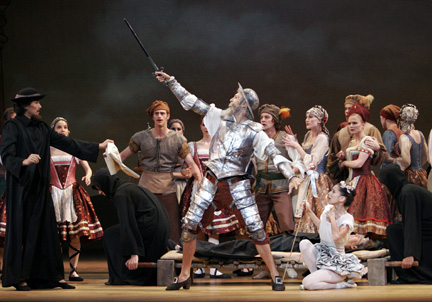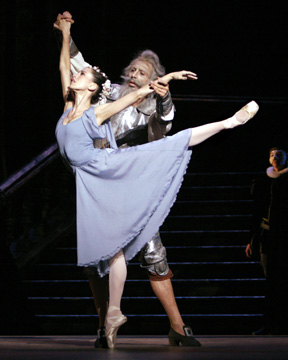"Balanchine's
Don Quixote"
The Suzanne Farrell Ballet (with The National Ballet of Canada)
Opera House, The Kennedy Center for the Performing Arts
Washington, DC, USA
Wednesday, June 22, 2005
by
George Jackson
copyright
©2005 by George Jackson
 The
steps and gestures are on stage again. Now all that Suzanne Farrell has
to do is breathe life back into George Balanchine's "Don Quixote".
There were moments tonight in her production when action, pose and even
the dancing took on meaning and the giant body of this unfinished masterpiece
stirred to move one's feelings. Prior to Act 1, at the beginning of the
Prologue, we saw the odd figure of the old Don struggling with his visions.
He was wild, yet meant well and deserved our pity. At the very end, in
the Epilogue that follows Act 3 and after all that happened during the
ballet's two and a half hour's running time, we mourned the Don's death
as we realized, too, that it is his triumph. Momchil Mladenov mimed a
plausible Don Q throughout, sometimes busily. What he had not was a Dulcinea
worthy of the name. The Dulcinea role's dancing was born from a sense
of daring. In repose, she used to be suffused with innate grace. Sandra
Rodriguez, Farrell's first cast Dulcinea, must have been so scared by
her opening night assignment that she hid any evidence of individuality.
She danced neatly, not in the driven way Balanchine's off-center balancing
and segmented linearity call for. Rodriguez declined to project.
The
steps and gestures are on stage again. Now all that Suzanne Farrell has
to do is breathe life back into George Balanchine's "Don Quixote".
There were moments tonight in her production when action, pose and even
the dancing took on meaning and the giant body of this unfinished masterpiece
stirred to move one's feelings. Prior to Act 1, at the beginning of the
Prologue, we saw the odd figure of the old Don struggling with his visions.
He was wild, yet meant well and deserved our pity. At the very end, in
the Epilogue that follows Act 3 and after all that happened during the
ballet's two and a half hour's running time, we mourned the Don's death
as we realized, too, that it is his triumph. Momchil Mladenov mimed a
plausible Don Q throughout, sometimes busily. What he had not was a Dulcinea
worthy of the name. The Dulcinea role's dancing was born from a sense
of daring. In repose, she used to be suffused with innate grace. Sandra
Rodriguez, Farrell's first cast Dulcinea, must have been so scared by
her opening night assignment that she hid any evidence of individuality.
She danced neatly, not in the driven way Balanchine's off-center balancing
and segmented linearity call for. Rodriguez declined to project.
 Farrell,
in staging the ballet, rehearsed it backwards, as Balanchine choreographed
it, attending to Act 1 last. She rearranged and streamlined the sequence
of the Don's first mishaps, yet the result doesn't resonate. The best
dancing in "Don Quixote" always seemed to spring from a demonic
or a sacred urge, and the ballet's highpoints of drama were revealed briefly,
as if in lightning flashes. At heart, it was a work one could get lost
in. However, there were also passages of dancing by ordinary characters,
especially at the beginning. These mundane parts needed stirring up. Balanchine
seemed unable to make movement that was morally neutral. Nevertheless,
from the ballet's 1965 premiere and for the dozen years it was in New
York City Ballet's repertory, he kept reworking those portions but to
little effect. Tonight, the villagers who deliver the first real dancing,
character dancing, seemed not just formulaic but cardboard flat. And shouldn't
there be more people in the village square, enough to make a crowd? The
jewel here was a classical solo (danced by Dulcinea in the guise of a
Cruel Shepherdess, Marcela). Tonight it looked like a classroom exercise.
A glint of what Act 1 could be came in the personage of the Duchess, played
by Mariaelena Ruiz with all the deliberate ambiguity of one of Velasquez's
royal portraits.
Farrell,
in staging the ballet, rehearsed it backwards, as Balanchine choreographed
it, attending to Act 1 last. She rearranged and streamlined the sequence
of the Don's first mishaps, yet the result doesn't resonate. The best
dancing in "Don Quixote" always seemed to spring from a demonic
or a sacred urge, and the ballet's highpoints of drama were revealed briefly,
as if in lightning flashes. At heart, it was a work one could get lost
in. However, there were also passages of dancing by ordinary characters,
especially at the beginning. These mundane parts needed stirring up. Balanchine
seemed unable to make movement that was morally neutral. Nevertheless,
from the ballet's 1965 premiere and for the dozen years it was in New
York City Ballet's repertory, he kept reworking those portions but to
little effect. Tonight, the villagers who deliver the first real dancing,
character dancing, seemed not just formulaic but cardboard flat. And shouldn't
there be more people in the village square, enough to make a crowd? The
jewel here was a classical solo (danced by Dulcinea in the guise of a
Cruel Shepherdess, Marcela). Tonight it looked like a classroom exercise.
A glint of what Act 1 could be came in the personage of the Duchess, played
by Mariaelena Ruiz with all the deliberate ambiguity of one of Velasquez's
royal portraits.
Act 2 is Balanchine's vision of a node of worldly power, the Duchess'
court. It is a place cruel to the core, and neither etiquette, masks nor
divertissements suffice to disguise this truth. Tonight's divertissement
dancers seemed aware of the duplicity of their task. Erin Mahoney poured
her tall self into her steps' tipped angularity as if to suggest she could
never be betrayed by herself, her partner or any partner. The compact
Shannon Parsley expressed pleasure in her finely faceted choreography
as if it alone sufficed to mollify. Natalia Magicaballi's chiseled attack
also diverted attention from the cold courtesy being shown the Don, as
did Bonnie Pickard's thoughtful sensuality that stood in stark contrast
with the innocence of her child attendant, Kiva McGhee. The courtiers,
though, didn't seem evil while waiting. Again, there were too few people
on stage. The Don's final humiliation in this act, the pie dough in the
face, seemed just a bit underplayed and a spotlight in place of Dulcinea
might have given the poor man more consolation than Rodriguez's portrayal.
Act 3 contains the work's dream ballet, blanc et noir. This dream, an
incisive study in harmony and turbulence, began blandly tonight. There
were trained dancers on stage, but few of them seemed stylists. The men,
especially, worked hard but made little impact. Perhaps, now that opening
night is over, the dream's calm portions will catch the light. Rodriguez,
though, seemed to emerge a little from her anonymity, or was it a matter
of becoming used to her? Mahoney simmered as the leading lady of the noir
forces. After his dream, the Don tilts against windmills, which leads
to his ultimately fatal injury and transport home in a cage.
Experiments require repetition. By the time this review is posted, "Balanchine's
Don Quixote" will have been tried six more times. Even that may not
suffice for those who believe in this ballet.
For the Record:
Music. Nicolas Nabokov's score has been edited by Ron J. Matson, The Suzanne
Farrell Ballet's music director. Ormsby Wilkins, of The National Ballet
of Canada, conducted on opening night. Nabokov's composition received
adverse criticism for being thin and confusingly diverse during the production's
years in New York City Ballet's repertory. Nabokov kept reworking the
music, just as Balanchine did the choreography. After the last NYCB performance,
Nabokov said to his wife "Now I know what to do". Presumably
he intended to do more re-composing but died the following spring, on
April 6, 1978. Tonight, the music sounded still diverse, but richer than
I remembered it.
Production. Suzanne Farrell undertook the re-staging of "Don Quixote"
essentially by herself. She had a little help from her former NYCB colleague
Susan Pillare. Another former colleague, David Richardson, who used to
rehearse the children for NYCB, is acknowledged in the printed program
but not for a specific task. When stories about reviving "Don Quixote"
first surfaced a few years ago, the Bolshoi Ballet was mentioned as a
possible collaborator.
Properties & Effects. The original scenery by Esteban Frances and
costumes by Karinska evoked the great painters of Spain. Those by Zack
Brown and Holly Hynes for the current production are more practical for
touring. Brad Fields designed the lighting. There are welcome visual effects:
the moving clouds across the front curtain enliven the painted panorama;
the starry sky above enlivened tonight's performance of the dream ballet.
Other effects are unwelcome: Dulcinea's name written into the sky by those
front curtain clouds; the glowing red lines of the windmill giant's eyes
that seem space-age; the jarring orange vests for the two subsidiary male
soloists in the dream ballet; the Don's awkwardly mechanical levitation
prior to his death which was magical in the original production.
Photos:
First: Sonia Rodriquez, Momchil Mladenov and company in Balanchine's
"Don Quixote." Photo: Paul Kolnik.
Second: Sonia Rodriquez, Momchil Mladenov in Balanchine's
"Don Quixote." Photo: Paul Kolnik.
Volume 3,
No. 25
June 27, 2005
copyright
©2005
George Jackson
www.danceviewtimes.com
|
|